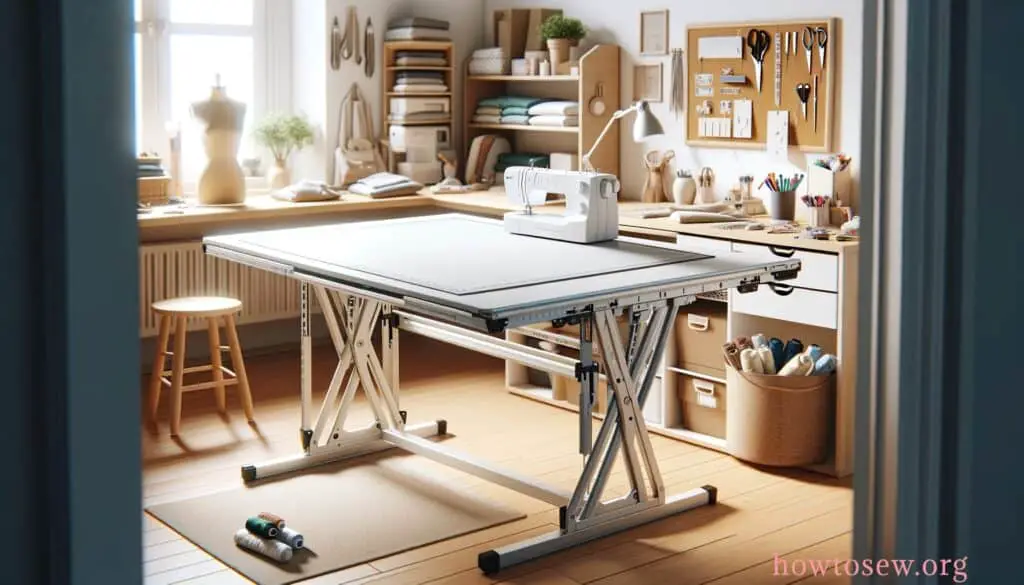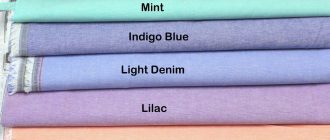Fabric Cutting Table: Combining Functionality and Style
In sewing and fabric crafting, the cutting table is of paramount importance.
It’s not merely a surface to cut fabric; it’s a cornerstone that defines the workflow, precision, and overall efficiency of sewing projects.
From the bustling ateliers of haute couture to the tranquil sewing rooms of hobbyists, the cutting table stands as an essential tool, shaping the way fabric is transformed into garments and other textile creations.
The significance of a high-quality fabric-cutting table cannot be overstated.
A well-designed table can revolutionize your sewing experience, elevating it from a routine task to an enjoyable and productive endeavor.
With the right table, you gain a reliable, stable, and adaptable partner in your creative journey.
It provides a foundation for accurate cuts, crucial for professional-looking results.
A cutting table designed with ergonomics in mind can also enhance comfort during long sewing sessions, reducing physical strain and boosting overall enjoyment.
In essence, the cutting table is a silent ally in sewing.
Its presence, often taken for granted, is fundamental to the success of every project.
A good cutting table simplifies the process of cutting fabric and enriches the sewing experience, making it more efficient, precise, and enjoyable.
As we delve deeper into the features that define a high-quality sewing cutting table, we’ll uncover how this humble piece of furniture can become a game-changer in the world of sewing and fabric arts.
Best Fabric Cutting Tables
As Amazon Associates, we may earn from qualifying purchases.
Understanding Fabric Cutting Tables

Definition and Purpose
Fabric cutting tables are an integral component of the sewing process.
Initially developed as basic platforms for cutting and measuring fabrics, they have evolved significantly.
They serve as the primary workspace where precision meets creativity, enabling sewers to align, measure, and cut fabrics easily.
The essence of a cutting table lies in its ability to facilitate accurate cuts, which are vital for the quality and fit of the final garment.
Historical Evolution
Tracing the lineage of fabric cutting tables reveals a history as rich as sewing.
From rudimentary wooden surfaces in small tailor shops to today’s advanced, feature-laden tables, these tables have mirrored the evolution of sewing.
The Industrial Revolution marked a significant shift, introducing mass production in the textile industry, where cutting tables became essential for efficiency.
Today, they incorporate modern design, ergonomics, and technology elements, reflecting the dynamic nature of fashion and textile arts.
The Role in Sewing
The role of a cutting table in sewing is multifaceted.
It’s the starting point of any sewing project, where ideas take a tangible form.
The cutting table is where fabric is transformed from a mere piece of cloth into parts of a future garment or textile product.
It’s a space that demands precision, as cuts’ accuracy directly influences the final product’s quality.
The cutting table is also a hub of the organization, where tools and materials are arranged for optimal workflow, underscoring its pivotal role in the sewing process.

Key Features of a High-Quality Cutting Table
Size and Space
When it comes to fabric-cutting tables, size does matter.
The ideal dimensions should be large enough to handle various fabric sizes while fitting comfortably in your sewing space.
A standard recommendation is a table four feet wide by six feet long, providing ample space to maneuver fabric without causing obstruction or inconvenience.
This size consideration is crucial for practicality and comfort during the sewing process.
Material and Build
The choice of material for a cutting table is a decisive factor in its durability and functionality.
Commonly, tables are crafted from robust materials like wood or metal, ensuring they can withstand the weight and wear of regular use.
The tabletop must be flat, stable, and sturdy, resisting warping and damage over time.
High-quality materials extend the table’s lifespan and provide a reliable surface for precise cutting.
Height and Ergonomics
The height of a fabric cutting table is critical for maintaining comfort and preventing physical strain.
Ideally, the table should be waist-high, typically around 34 to 36 inches, allowing for a natural, upright posture while working.
This ergonomic consideration helps reduce back, neck, and shoulder stress, making cutting more enjoyable and less tiring.
Adjustability in height can be an added advantage, catering to the individual needs of different users.
Surface and Stability
A superior cutting table should have a flat, stable surface, preferably equipped with a self-healing mat.
This feature protects the table and provides a non-slip surface for fabric, enhancing safety and accuracy in cutting.
Stability is equally important; a wobbly table can lead to imprecise cuts and even accidents.
Ensuring the table remains firmly in place during use is essential for safety and precision.
Portability and Storage
In modern sewing spaces, portability and storage options are highly valued.
Tables with wheels or casters offer mobility, allowing for easy rearrangement of the workspace as needed.
Additionally, built-in storage options like drawers or shelves are beneficial for organizing sewing tools and materials, keeping them within reach, and maintaining a clutter-free workspace.
Additional Functionalities
Modern cutting tables often come with features that enhance their utility.
These may include folding mechanisms for easy storage, height adjustability for ergonomic comfort, and even electric controls for effortless height changes.
These added features contribute to the table’s overall functionality, making the sewing process more efficient and adaptable to various project needs.
Types of Cutting Tables for Different Needs
Folding Tables
Folding tables are an excellent solution for sewers working in limited spaces.
Their design allows for easy storage when not in use, making them perfect for those who need to maximize their workspace’s versatility.
Typically, these tables can be set up quickly and provide a sufficient cutting area while still being compact enough to tuck away neatly.
Adjustable Height Tables
Adjustable height tables cater to the ergonomic needs of various users.
They allow you to comfortably modify the table’s height, reducing strain on the back and shoulders.
This feature is particularly beneficial for sewers who spend long hours at the table, enabling them to maintain a comfortable posture throughout their work.
Electric Cutting Tables
Electric cutting tables offer convenience and ease of use with their automated height adjustment capabilities.
The table can be raised or lowered at the push of a button, accommodating different tasks and user heights.
This type of table is ideal for shared sewing spaces or educational environments where multiple users with varying needs may use the table.
Wall-Mounted Folding Tables
Wall-mounted folding tables are a space-saving wonder.
They can be mounted and folded on the wall, providing a large cutting surface without occupying floor space.
This table type is perfect for small sewing rooms or multipurpose spaces where every inch counts.
It can be folded back up when unused, leaving the room free for other activities.

Choosing the Right Cutting Table
Assessing Your Space and Needs
The first step in selecting the ideal cutting table involves evaluating your available space and specific requirements.
It’s crucial to choose a table that comfortably fits in your sewing area without overcrowding it.
Additionally, consider the types of sewing projects you typically undertake.
This will guide you in choosing a table that fits spatially and aligns with your sewing needs.
Stability and Durability
A high-quality cutting table must be stable and durable.
Stability ensures precision in cutting and reduces the risk of accidents.
Look for tables that are well-constructed and don’t wobble during use.
The table’s durability is also important, especially if you use it extensively.
Opt for tables made from sturdy materials like high gauge steel or solid wood, which can endure the rigors of regular sewing tasks.
Budget Considerations
The cost of a cutting table can vary significantly, and finding one that offers value for your investment is important.
While it may be tempting to choose a less expensive option, consider the long-term durability and functionality of the table.
A good quality cutting table can be a significant investment, but its reliability and contribution to a more efficient sewing process pay off in the long run.
Maintenance and Care
Cleaning and Upkeep
Maintaining your cutting table is essential to ensure its longevity and functionality.
Regular cleaning is key; wiping the table with a damp cloth after each use helps to keep it free from fabric fibers and dust.
For tables made of wood or metal, occasional waxing or polishing can protect the surface and maintain its finish.
This routine maintenance keeps the table looking good and ensures a smooth, clean surface for accurate fabric cutting.
Warranty and Support
When purchasing a cutting table, consider the warranty and customer support options.
A good warranty can provide peace of mind, covering any potential manufacturing defects or issues that may arise.
Additionally, reliable customer support from the manufacturer can be invaluable, offering assistance and advice for assembly, maintenance, or any operational concerns.
Investing in a table with a solid warranty and support system ensures your workspace remains functional and productive for years.
Enhancing Productivity and Organization
Organizational Tips
A well-organized cutting table can significantly enhance your productivity.
Consider incorporating features like built-in shelves, drawers, or racks to keep essential tools and materials within easy reach.
Organize your scissors, measuring tapes, pins, and other tools to make them easily accessible.
This organization saves time and tidies the workspace, making the sewing process more enjoyable and efficient.
Incorporating an Ironing Station
Adding an ironing station to your cutting table setup can be a game-changer.
You can either iron directly on a section of the cutting table, protected by a suitable heat-resistant surface, or place a small ironing board adjacent.
This integration allows for immediate pressing of fabric and seams, a critical step in achieving professional-quality sewing results.
The convenience of having an ironing station close to your cutting area streamlines your workflow and saves valuable time.
By focusing on organization and incorporating multifunctional elements like an ironing station, your sewing cutting table can become a powerhouse of efficiency and creativity, significantly enhancing your sewing experience.

Conclusion
In conclusion, the sewing cutting table is more than just a piece of furniture; it’s a central hub for creativity and precision in the sewing world.
From its size and construction to its ergonomic design and additional functionalities, every aspect of a high-quality cutting table is designed to enhance the sewing experience.
By choosing the right table, maintaining it well, and optimizing it for organization and functionality, sewers can transform their sewing area into an efficient, enjoyable workspace.
Whether you’re a professional tailor, a fashion designer, or a hobbyist, understanding and investing in the right cutting table is key to achieving impeccable sewing results and enjoying the process to its fullest.





